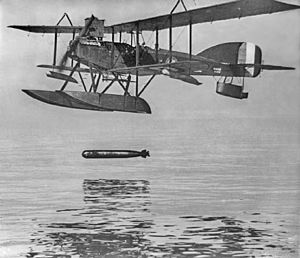Short Type 320
| Short 320 | |
|---|---|

| |
| Role | Seaplane |
| Manufacturer | Short |
| Introduction | 1916 |
| Primary user | |
| Number built | 125[1] - ≥137 [2] |
| Wingspan | 22.8 m (74 ft 10 in)[3] |
| Engine | 320hp Sunbeam Cossack vee-12 |
| Armament | flexible turret Lewis torpedo or 2×230lb bombs [2] |
| Crew | 1-2 [note 1] |
| Max Speed | 116 km/h (72 mph)[3] - 127 km/h (79 mph) [2] |
| Climb | 610 m (2,000 ft) in 11:50[2] 910 m (3,000 ft) in 19:30[3] 1,500 m (5,000 ft) in 53:30[3] |
| Service Ceiling | 1,100 m (3,500 ft)[3] - 1,700 m (5,500 ft)[2] [note 2] |
| Endurance | 6:00 [2][3] |
While most Short seaplanes are known by their Admiralty Type Number, the Short 320 derived its name from its 320hp Sunbeam Cossack engine. Designed to carry a 1000lb Mark IX torpedo, but like most seaplanes it spent more time in long-range reconnaissance and anti-submarine patrols. The arrangement of the armament was unusual: the pilot sat in the back but the observer was provided with a turret level with the upper wing, allowing 360° fire at the penalty of having to stand in order to fire.
The type 320 stayed in service from 1916 through the Armistice, though never in the large numbers of the Short Type 184. They were used out of Britain RNAS stations and the Mediterranean. [2]
They were used out of Taranto and Malta and out of the US Naval Air Station at Killingholme. Forty were still on hand at the Armistice, when they were declared obsolete.[1]
For more information, see Wikipedia:Short Type 320.
References
- Notes
- Citations
- Bibliography
- J.M. Bruce. British Aeroplanes 1914-18. Great Britain: Funk & Wagnalls, 1957, 1969. ISBN 0370000382
- Heinz J. Nowarra, Bruce Robertson, and Peter G. Cooksley. Marine Aircraft of the 1914-1918 War. Letchworth, Herts, England: Harleyford Publications Limited, 1966. ISBN 0900435070